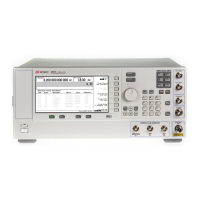E8257D/67D, E8663D PSG Signal Generators Service Guide
1- 1
1 Troubleshooting
• “Electrostatic Discharge (ESD) Information” on page 1- 1
• “Getting Started with Troubleshooting” on page 1- 2
• “A18 CPU Turn–On Test” on page 1- 3
• “Self–Test Failures and Related Troubleshooting” on page 1- 6
• “Troubleshooting Assembly–Level Problems” on page 1- 10
• “Troubleshooting Unlocks” on page 1- 64
• “Troubleshooting Unlevels” on page 1- 67
• “Troubleshooting Adjustment Problems” on page 1- 72
• “Troubleshooting ADC Adjustment Failures” on page 1- 74
• “Troubleshooting Performance Test Problems” on page 1- 74
• “Troubleshooting the RF Path” on page 1- 75
• “Troubleshooting Harmonic Spurious” on page 1- 78
• “Troubleshooting Non–Harmonic Spurious” on page 1- 81
• “Troubleshooting Option UNR/UNX/UNY and Instruments with Serial Prefixes >= US4805/MY4805 Phase Noise” on
page 1- 82
• “Overall Description” on page 1- 83
• “Reference/Synthesis Loop Description” on page 1- 93
• “RF Path Description (Frequency Generation, Level Control, and Modulation)” on page 1- 99
• “Self–Test Overview” on page 1- 121
• “Contacting Agilent Technologies” on page 1- 122
WARNING Troubleshooting instructions are for use by qualified personnel only. To avoid electrical shock, do not
perform any troubleshooting unless qualified.
The opening of covers or removal of parts is likely to expose dangerous voltages. Disconnect the
signal generator from all voltage sources before it is opened.
Electrostatic Discharge (ESD) Information
WARNING The following techniques related to ESD and static–safe workstations should not be used when
working on circuitry with a voltage potential greater than 500 volts.
ESD can damage or destroy electronic components. All work on electronic assemblies should be performed at a
static–safe workstation using two types of static–safe workstation protection:
• conductive table–mat and wrist–strap combination
• conductive floor–mat and heel–strap combination
Both types, when used together, provide a significant level of ESD protection. Of the two, only the table–mat and
wrist–strap combination provides adequate ESD protection when used alone. To ensure user safety, the static–safe
accessories must provide at least 1 MΩ of isolation from ground.

